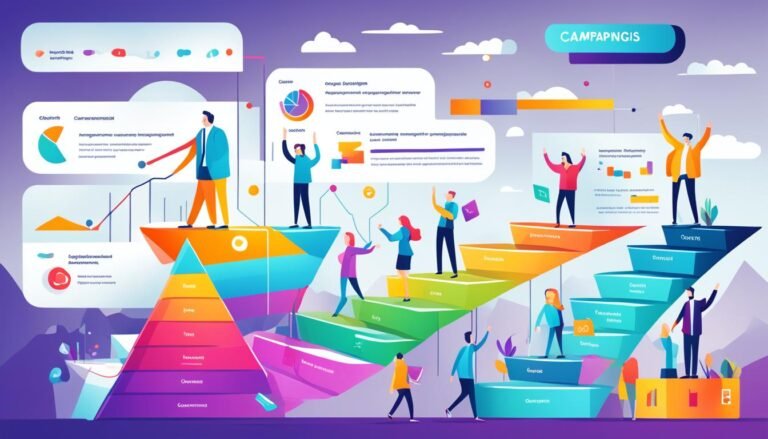Growth Hacking: Rapid Customer Acquisition and Retention
Did you know that businesses lose over $1.6 trillion each year because customers switch to competitors? This shows how vital it is to not just get new customers but also to keep the ones you have. Growth hacking is a new way to do this. It uses data and low-cost marketing to quickly get and keep customers.
Growth hacking is key for startups and small businesses with limited budgets. It means trying out different marketing ways fast to see what works best. This approach helps companies grow quickly. What makes growth hacking special is its focus on keeping customers happy. Forbes says keeping a customer costs much less than finding a new one.
Also, keeping just 5% more customers can make a business 25% to 95% more profitable, as Review42 found. Focusing on getting and keeping customers together helps businesses grow and make more money. Over 65% of a company’s sales often come from customers it already has. This shows how crucial keeping customers is for long-term success.
Key Takeaways
- Keeping customers is much cheaper than finding new ones.
- Just a 5% increase in keeping customers can greatly increase profits.
- Most of a company’s sales come from customers it already has.
- Great customer service leads to more repeat business.
- Growth hacking uses fast testing and data to help businesses grow.
Introduction to Growth Hacking
Growth hacking is a big topic in digital marketing today. It was first used by Sean Ellis in 2010. It’s all about growing fast by finding the best ways and strategies.
What is Growth Hacking?
Growth hacking uses data and experiments to market products. It’s all about making smart choices based on data. This method comes from Silicon Valley startups. It’s about quick tests and creative ideas to get and keep customers.
This method often means trying many things at once. Companies use it to get more customers and keep them. They focus on low-cost ways to grow.
The Evolution of Growth Hacking
Growth hacking has changed a lot since it started. It used to be just for Silicon Valley startups with big growth goals. Now, it’s used by many companies.
Companies that use data and move fast do better. For example, Twitter grew a lot by testing and trying new things. They went from 54 million users in 2010 to 185 million by 2012.
Good growth hacking means setting clear goals and watching important numbers. Using automation and AI helps too. Companies like Dropbox and Airbnb grew fast with smart, cheap tactics. Marketing funnel optimization helped them give customers what they wanted.
Getting customers the old way is getting pricier. So, companies are using new ways like growth hacking. This shows how important it is to think creatively and work together to keep customers happy.
Importance of Customer Retention
Customer retention is key to a business’s growth, especially for those that need repeat purchases. It’s cheaper and more effective than getting new customers. This approach helps businesses grow over time.
Why Retention Matters
Amazon Prime is a great example of how keeping customers is crucial. In 2016, many thought Amazon Prime wouldn’t be profitable without its high retention rates. Prime members buy more than non-members, boosting revenue and helping the company grow.
Blue Apron also shows how important retention is. Despite spending nearly $500 million in four years, it focused too much on getting new customers. This led to 72% of users leaving within six months, causing financial issues.
Cost-Effectiveness of Retention vs. Acquisition
Studies show keeping customers is cheaper than getting new ones. By the end of this year, 25% of companies will use chatbots to make customers happier. Email campaigns also bring in a big return, showing how effective retention can be.
Retention has a big impact on how much money a customer can make over time. Once a company keeps more than 0.5 of its customers, small improvements can lead to big gains. This shows the importance of balancing keeping customers with getting new ones to make more money.
Understanding the worth of each kept customer is key to lasting growth. With AI, companies can spot customers likely to leave and keep them happy. This way, they can make more money and keep customers longer.
User Engagement Strategies
To build a lasting relationship with customers, it’s key to use effective user engagement strategies. Techniques like customer service chatbots and email campaigns meet the unique needs of users. This keeps them happy and loyal. Here are some strategies and tools to boost user engagement:
Effective Engagement Techniques
- Email Campaigns: Personalized email campaigns keep customers engaged. They offer promotions, updates, and valuable content. This keeps them interested in your brand.
- Customer Service Chatbots: Chatbots improve customer service by offering quick help. They reduce the churn rate by quickly solving customer problems.
- Collecting Reviews: Getting user reviews shows how satisfied customers are. It also points out areas to improve your engagement strategies.
- Gamification: Adding fun elements makes users more engaged. For example, Duolingo uses gamification to keep users coming back.
Tools for Monitoring User Engagement
It’s important to keep an eye on how users interact with your platform. This helps you see what works and what doesn’t. Here are some useful tools:
- Google Analytics: This tool tracks how users behave on your site. It shows where they come from, who they are, and how they engage with your content.
- Hotjar: Hotjar uses heatmaps and recordings to show how users move through your site. You can see what they click on and how they use your features.
- Customer Feedback Tools: Tools like SurveyMonkey and Typeform collect direct feedback. They give you a clear view of what users think and expect.
- Email Campaign Analytics: Most email marketing tools have analytics. These help you see how well your campaigns do. You can track opens, clicks, and improve your emails for better results.
Using these strategies and tools helps businesses build stronger customer relationships. It also reduces the churn rate. This leads to growth and success over time.
Viral Marketing Techniques
Viral marketing uses customer networks to grow quickly. It taps into the power of word-of-mouth marketing. This method is key for businesses wanting to get noticed without spending a lot on ads.
Types of Viral Marketing
There are several types of viral marketing that work well for brands:
- Referral Programs: For example, Dropbox gave extra storage to users who brought in new users. This created a loop that increased user engagement and growth.
- Influencer Marketing: Brands work with influencers who share promo codes. Uber used influencer codes to spread the word on social media, reaching more people.
- Social Sharing Features: Adding social sharing options, like Spotify did with Facebook, makes it easy for users to share content. This helps keep users engaged and interested.
Case Studies of Successful Campaigns
Real examples show how viral content and word-of-mouth marketing work:
- Dropbox: Offering more storage for referrals helped Dropbox grow its user base quickly.
- Airbnb: Posting listings on Craigslist helped Airbnb reach more people at a low cost.
- Uber: Promotions and surge pricing helped Uber manage demand and get users to share referral codes.
- Zoom: Zoom’s easy sharing and collaboration tools helped it grow to hundreds of millions of users.
These examples prove viral marketing is great for growing users, increasing visibility, and cutting costs. By focusing on the viral factor and improving invite flows, businesses can grow exponentially. This approach brings in more users without spamming, focusing on what users want instead.
Data-Driven Growth Experiments
Using data-driven growth experiments helps businesses grow fast without spending a lot. They use advanced analytics and machine learning in business to predict what customers like. This way, they can make better choices.
Multi-armed bandit testing is a great method for this. It lets companies test many options at once and see which ones work best. This speeds up making decisions and saves resources.
Predictive analytics is another key tool. It uses past data to guess what will happen in the future. By understanding what customers want, businesses can make products that people like. For example, Netflix uses it to suggest shows and movies, keeping users happy and loyal.
Adding machine learning in business means constant learning and getting better. Companies that use machine learning can automate many tasks. This frees up time for more important work. Amazon, for example, uses machine learning to improve their supply chain and make shopping better for customers. This leads to more sales and loyal customers.
Lean Startup Methodologies
Lean startup methods focus on making products better and learning from customers. They use a build-measure-learn cycle to quickly meet customer needs. This way, companies can cut waste and make their products better for the market.
At the heart of lean startup is making products better through continuous improvement. Companies build, test, and learn from what customers say. For example, startups testing MVPs see a 35% higher rate of keeping customers.
Using the build-measure-learn feedback loop boosts conversion rates by 25%. This method means making decisions based on real user data. It helps make sure each product update is based on what users want.
Lean startups are flexible and can change based on what users say. This flexibility leads to a 40% higher growth rate for companies that listen to their users. Being able to adapt is key for startups to find their place in the market.
- Dropbox’s referral program led to a 60% increase in signups, showcasing growth hacking’s power.
- Airbnb’s Craigslist integration boosted bookings by 10%, proving strategic partnerships’ impact.
In summary, lean startup methods like iterative development and validated learning help startups grow fast and efficiently. These methods are key to success in today’s fast-paced business world.
Customer Lifecycle Management
Managing the customer lifecycle is key to growing a business and keeping customers loyal. By knowing the steps customers take from first contact to becoming advocates, companies can plan better. This includes mapping the customer journey, optimizing each stage, and segmenting customers.
Understanding the Customer Journey
Customer journey mapping lets companies see things from the customer’s point of view. It starts with awareness, moves to considering and buying, and ends with loyalty and advocacy. Since journeys differ, businesses must be flexible to meet various needs.
The benefits of customer journey mapping are clear. It helps find pain points and ways to improve engagement.
Strategies at Different Lifecycle Stages
Companies must focus on each stage of the customer journey with lifecycle optimization. Strategies include:
- Awareness: Using content marketing, social media, and SEO to draw in potential customers.
- Consideration: Offering informative materials, email marketing, and personalized interactions to build interest.
- Purchase: Making buying easy, offering deals, and ensuring a smooth transaction.
- Loyalty and Advocacy: Using reward programs, asking for feedback, and encouraging referrals to build strong relationships.
Using smart customer segmentation helps send the right messages to each group at their stage. This boosts engagement, increases conversions, and makes customers happier.
Funnel Optimization
Optimizing your sales funnel is key to boosting conversion rate and making your funnel more efficient. Focus on each stage, from getting noticed to making a purchase. This ensures smoother transitions and more conversions.
Using strong lead nurturing techniques keeps customers engaged and guides them through the sales process. For example, Totango saw a 10% increase in conversions by not asking for credit card info upfront.
Since 79% of marketing leads don’t turn into sales, it’s vital to analyze and improve each funnel stage. InsightSquared boosted its conversion rates by 112% just by cutting one form field.
Targeting the right customers and keeping a 3:1 ratio between Customer Lifetime Value (CLV) and Customer Acquisition Cost (CAC) helps increase revenue. A better sales funnel efficiency means fewer prospects drop off, leading to more paying customers.
Real examples show how well a well-optimized funnel works. Dropbox got 60% more subscriptions with a viral referral program. PayPal saw a 23% increase in payments. Autopilot gained 2,500 customers in just 24 months by limiting free actions.
In conclusion, optimizing your funnel is an ongoing task. It means making regular changes and checking how each stage is doing. By doing this, businesses can greatly improve their conversion rates and use lead nurturing techniques for long-term success.
Referral Programs
Referral programs are key for businesses looking to grow. Companies like Dropbox show how a good referral program can really help. They got 35% of daily sign-ups from their referral system.
How to Design Effective Referral Programs
Creating a great referral program means knowing what motivates customers and making it easy to use. Offering rewards that match what customers want is important. Using both cash and non-cash rewards helps reach more people.
It’s important to make referring others easy and clear. Tools that automate the process make it better for users and can make things 30% more efficient. Working with other brands can also help spread the word, like Red Bull and GoPro did.
Measuring the Success of Referral Programs
To see how well referral programs work, businesses need good tracking systems. Keeping an eye on things like how many people refer others, how many of those referrals turn into customers, and the return on investment is key. For example, Ryanair got over 1.9 million sign-ups with their TikTok strategy, showing the power of tracking.
It’s also important to look at the value of customers who came from referrals versus those who didn’t. Knowing how much referred customers are worth helps improve the program. This way, businesses can keep getting new customers and keep the ones they have.
By carefully designing and watching referral programs, businesses can grow a lot and keep customers coming back. Companies like Airbnb and HubSpot show how important it is to have a good referral program and track its success. This helps a company grow and stay strong.
A/B Testing
A/B testing is a key growth hacking method. It tests different versions of a website or marketing campaign to see which one gets better results. This helps businesses improve their strategies by making data-driven choices.
Setting Up A/B Tests
Starting an A/B test starts with a clear idea. This idea should come from what you’ve noticed or learned about user behavior. It should aim to boost things like user engagement or conversion rates. Here are the main steps:
- Define the Goal: Figure out what you want to achieve, like getting more people to click on a button.
- Create Variations: Make two or more versions of what you’re testing.
- Split the Audience: Randomly put users into each version to get fair results.
- Launch and Monitor: Run the test and track how users interact with it.
By doing these steps, companies can use A/B test analytics to learn important things. This helps them get better at getting and keeping customers.
Interpreting A/B Test Results
When looking at A/B test results, it’s important to understand the data. You need to see if the differences you found are real or just random. Here are some key points:
“Statistical significance is key to know if the changes you made really made a difference or if it was just luck.”
- Check the Sample Size: Make sure enough users tried each version for the results to be trustworthy.
- Analyze Performance Metrics: Look at important metrics like conversion rates and user engagement to see which version worked best.
- Determine Significance: Use stats to confirm that the differences you saw weren’t just by chance.
Good A/B testing lets companies try out different things to see what works best. This way, they can make changes that improve the user experience and get better results.
Conversion Rate Optimization
Improving your website’s conversion rates is key to success. It means making more users take the action you want, like buying something or signing up. By analyzing the user journey and enhancing their experience, you can boost conversion rates and grow your business.
Methods to Improve Conversion Rates
Start by analyzing your conversion funnel. This shows how users move through your site and where they get stuck. Once you know the issues, use these CRO best practices:
- Optimize Landing Pages: Make your landing pages clean, fast, and attractive. Use clear headlines, strong calls-to-action (CTAs), and persuasive content.
- A/B Testing: Test different parts of your pages, like headlines and images, to see what works best. This helps you make smarter choices.
- Improve User Experience (UX): Make your site easy to navigate, with fewer form fields and a mobile-friendly design. A smooth UX boosts conversion rates.
Tools and Software for CRO
For Conversion Rate Optimization, use tools and software that offer insights and help optimize. Here are some key tools:
- Google Analytics: A great tool for analyzing user behavior, traffic sources, and conversion paths.
- Hotjar: Provides heatmaps and session recordings to see how users interact with your site and spot areas for improvement.
- Optimizely: A powerful A/B testing tool for experimenting with your pages and tracking their performance to boost conversion rates.
By using these methods and tools, businesses can see big improvements in their conversion rates. A strong CRO strategy that includes analyzing the funnel and enhancing user experience can lead to lasting business growth.
Growth Hacking: Rapid Customer Acquisition and Retention
Growth hacking is all about quick and big growth through testing different strategies and channels. It’s about making sure your business grows in a way that lasts and lets you try new things in marketing.
At the heart of growth hacking is using data to make decisions. This means looking closely at data to see how things are doing. It’s a fast-paced world where you always need to check if what you’re doing is working, so you can keep making it better.
Viral marketing is a big part of growth hacking. It can make your growth explode if you have great content and a strong referral program. For example, Dropbox and Airbnb used these strategies to grow really fast.
Product-led growth is also key. It uses your product to get more customers and keep them coming back. This includes things like offering free versions of your product and making it easy for new users to start.
Content marketing and SEO are also crucial. They help you reach people without paying for ads. Content marketing gives people useful info, and SEO makes sure you show up high in search results. This helps more people find you.
Growth hacking isn’t just one thing. It’s about using many tools like social media, email marketing, and testing different versions of your product. Social media helps you talk to lots of people on sites like Facebook and Instagram. Email marketing is great for keeping in touch with customers and getting them to buy more.
By setting clear goals, coming up with ideas, picking what to test, checking results, trying again, and making things better, you can grow your business in a lasting way. The aim is to grow fast, keep customers, and make money, all while planning for the long run.
Conclusion
Growth hacking is key for startups and early companies wanting fast market growth. This summary shows how important it is to use smart strategies and new ideas. It helps get customers quickly and keep them.
By always testing and improving, companies can find the best ways to grow. This approach helps them stand out in a crowded market.
Even big companies can gain from growth hacking. It’s about quick wins through things like viral marketing. Growth marketing, on the other hand, looks at the big picture, making sure customers stay happy over time.
Together, these methods help businesses grow steadily and keep customers coming back. This mix of fast and long-term plans makes a strong business environment.
Being flexible and using data is vital in growth hacking. Tools like the AARRR framework and A/B testing help businesses grow. By setting goals and using social media, companies can always get better.
Combining growth hacking and marketing makes for a strong plan for business growth. This approach leads to lasting success.
Source Links
- Your Growth Hacking Guide to Customer Retention – Growth Marketing Genie
- Growth Hacking vs Growth Marketing: How to Leverage the Difference
- Growth Hacking: Product Management & Operations Explained
- Introduction to Growth Hacking Techniques for Social Media Marketing
- Growth Hacking For Marketers: A Starter Guide (2022)
- What Is Growth Hacking? Simple Definition + How to Get Started
- Hacking Growth Essentials — Part 7: Measuring, and Optimizing Retention
- Why retention is the ultimate growth hack
- Growth Hacking: Fuel To Your Retention Efforts
- Maven: Growth Hacking 101
- 10 Growth Hacking Examples to Boost Engagement and Revenue
- Why the best way to drive viral growth to increase retention and engagement at andrewchen
- Growth hacking and viral marketing: Growth Hacking Strategies: Driving Business Success – FasterCapital
- Growth Hacking Techniques for Rapid Business Growth
- Growth Hacking Explained: Methods, Metrics, and Mindsets
- Growth Hacking in 2024: The Ultimate Guide to Data-Driven Growth | Copy.ai
- Lean Startup Methodology in the World of Growth Hacking – FasterCapital
- Lean Startups: How to Manage Your Customer Acquisition – Start-up Shelter
- Growth Hacking: What is it and how you can do it
- Everything you need to know about growth hacking!
- 5 Key Strategies To Optimize Growth Hacking Funnel
- Growth hacking funnel: Funnel Hacks for Rapid Business Growth – FasterCapital
- What is Growth Hacking Definition and Strategies
- Commonly Overlooked Growth Hacking Techniques for Startups
- Hacking Growth Essentials — Part 5: Supercharging Customer Acquisition
- Mastering the Art of Growth Hacking: How to Take Your Business to the Next Level
- Growth Hacking Agency: Strategies for Rapid Business Expansion
- Growth Hacking 101: How to Unleash Your Business’s Potential
- Best Growth Hacking Strategies to Skyrocket Your Business – upGrowth
- Growth Hacking: Unleashing Rapid Growth for Your Business
- Growth Hacking vs. Growth Marketing deep dive
- Growth Hacking vs Growth Marketing: What’s the Difference?
- Growth Hacking and the Strategic Approach to the Marketing







